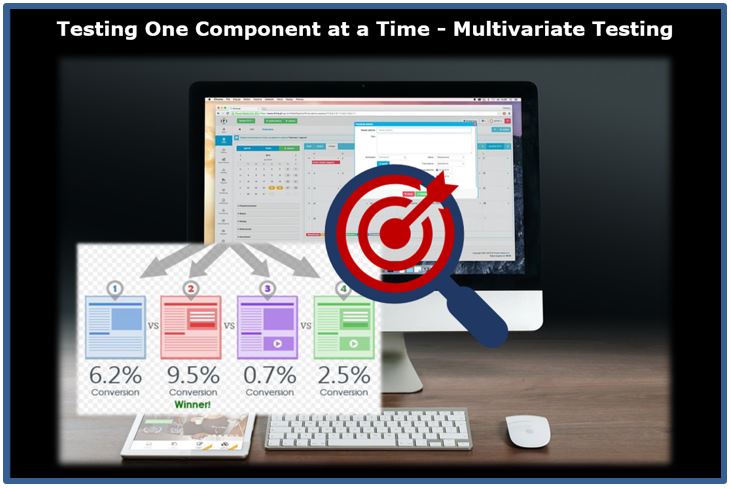Testing is evidently one of the most critical parts of all types of software and services to ensure reliability & accuracy to deliver impeccable customer experiences. Niche test practices emerge to keep up with the changing approaches in software development practices and the purposes of the system itself.
- Testing Approaches
- Testing Purposes
- IoT Testing
- Mobile Apps Testing
- BI & Big Data Testing
- Technology Specific Testing
Enter Multivariate Testing
Multivariate software testing formalizes checks and tests on the individual page components rather than considering full pages. With multivariate software tests, the quality assurance team identifies different elements and components of the website page where the tests are potentially planned to run. Multiple versions of the page are then visualized by different variations & combinations of individual elements.
Effectively, multivariate software testing focuses on identifying the winning combination from a set of all possible combinations.
Putting it Simply
To simplify, consider the plain aspect that desktop software, websites, or mobile apps are made up of multiple, flexible components. With multivariate software testing solutions, the testing team will change multiple components, like a flashy text box and an image at the same time. Three variations of an image combined with two caption or header variations will result in six content versions, which can be tested in parallel to determine the best possible version.
The multivariate test will always result in a total number of variations as below.
[Number of variations of component A] x [Number of variations of component B] = [Total number of variations]
Generating Accurate Results with Multivariate Testing
An aspect to consider with multivariate testing is the traffic requirement. Considering the possible number of combinations, developers or testers need to route more traffic to the test environment to generate accurate results. As the tests run concurrently, each test will consume a certain amount of traffic before appropriate results are received.
Comparatively, more traffic is required in multivariate software testing in contrast to A/B testing.
Conversion rates can improve up to 60% with the proper implementation of multivariate testing.
Multivariate software testing has proved to be a robust & powerful tool when it comes to analyzing complex customer behavior. Website optimization becomes an easier possibility using the data points generated from the testing cycle of this niche testing.
Multivariate Software Testing Vs. A/B testing
It is not only tough but also unfair to recommend or judge a testing technique. Whether to opt for Multivariate software testing or A/B testing will vary as per the requirement of an organization, the type of website or software they have implemented, the test environment as well as the QA team preferences.
Types of Multivariate Software Testing</p>
The different types of multivariate software testing can be classified based on the traffic distribution.
Full Factorial Testing
This is the most preferred type of multivariate testing, and it is done by giving equal justice to each component combination. Each element combination receives an equal amount of website traffic and based on the response, the winning combination is determined.
Here, the results are driven by hard numbers with limited assumptions, however, on the downside, traffic requirement is high.
Adaptive Multivariate Testing
This is a recent approach wherein user feedback is given importance and based on the real-time responses of website visitors, analysis is charted to determine the best possible combination.
Fractional Factorial Testing
In contrast to full factorial testing, in full factorial testing, only a certain number of component combinations are exposed to the site traffic. Based on mathematical calculations, the rest of the combinations undergo analysis to determine the best conversion possibilities.
To Be or Not to Be with Multivariate Software Testing Solutions
The Benefits
-
- Extremely effective when multiple components need to be modified on a single platform or page to result in conversion goals like increased clicks, shares or sign-ups
- Proper implementation will eliminate the need of running a large number of sequential A/B tests
- A large number of variations can be analyzed in a limited time frame
- Enterprise-level results have indicated better brand awareness with multivariate testing implementation
- Can increase online sales which are predominantly reliant on advertising or pay per clicks
- Proper selection of elements centered around marketing can help boost the marketing objectives of a business
The Challenges
-
- The key challenge with multivariate testing implementation is the amount of website traffic that needs to be generated for test results
- If one or more of the elements considered for testing are not related to the conversion goal, it will be difficult to yield conclusive results
- The size of sample traffic needs to be projected in advance to ensure result evaluation happens
On a Parting Note
SPEC QA, an acclaimed third-party software testing company in India ensures the right mix of traditional and modern Testing approaches and provides support through the Testing Life Cycles. The unbiased test reports help smoother implementations with near-zero post-delivery defects and higher customer satisfaction.
Request a FREE POC to Test Drive our Services








